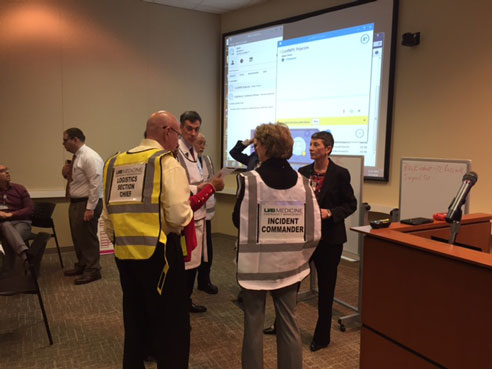 Drill participants in the UAB Hospital command center make plans during the severe weather exercise.
Drill participants in the UAB Hospital command center make plans during the severe weather exercise.
The University of Alabama at Birmingham held a full-scale disaster exercise with area hospitals, governments, and state and federal agencies today. The drill was designed to test emergency alert systems and response plans during and after a tornado. As part of the drill’s simulation, organizers announced that a major storm system, capable of producing long-track tornadoes, was moving toward the city of Birmingham.
“This drill brought together the entities that will be involved in any real emergency, including first responders, emergency management leadership from across the region and health care providers,” said Kyle Boyett, UAB Department of Emergency Management. “We know firsthand the risks to this region from severe weather, especially in the spring, and it is incumbent upon us to train, prepare and practice so that we are ready when a real emergency arises.”
Among the agencies involved in the drill were UAB and the UAB Health System, Children’s of Alabama, the Alabama Organ Center, Alabama Department of Public Health, Jefferson County Department of Health, Jefferson County Emergency Management Agency, Healthcare Community Amateur Radio Club, Birmingham Fire and Rescue, the National Weather Service, and the Federal Emergency Management Agency.
The events of the exercise took place in real time, as they would in a real emergency. Tornadoes were predicted for the campus and downtown Birmingham vicinity, and UAB students in class were asked what decisions they would make and what actions they would take. Students in the schools of Nursing, Business and Engineering took part.
A second phase of the exercise simulated mass casualties from a tornado touchdown in Birmingham. Hospitals geared up for an influx of severely injured patients. A total of 86 simulated patients were reported to event participants. Of those, participants were told that 45 were routed to one of the UAB Health System facilities: UAB Hospital, UAB Highlands or the Callahan Eye Hospital.
“A mass casualty experience puts tremendous pressure on health care delivery systems,” said Jvann Martin, co-chair of the UAB Health System’s Emergency Management team. “Drill participants had to rush into action to make plans to provide appropriate staffing levels, route equipment and supplies to where they would have been required and work out difficult logistic issues surrounding patient transport, bed availability and even the availability blood supply in the community.”
The event, which in its original planning stages was strictly a UAB Hospital exercise, quickly grew into a city-wide, and even regional exercise, as emergency management professionals have long recognized the importance of inter-agency communication and cooperation to provide the best possible response to situations that can tax all available resources.
“As we know from past experience, and even from the storm system that passed through the Birmingham area last night, the threat of severe weather is very real,” said Sarah Nafziger, M.D., co-chair of the UAB Health System’s emergency management team. “These drills help hospitals and all responding agencies establish best practices for preparing for and responding to severe weather events in an efficient and effective manner.”
The exercise was designed to test communications and response. Realistic radio traffic and emergency messaging were used to capture the feel of a real emergency. Amateur radio provided real time communications about the storm’s location and shared damage report information to UAB during the exercise.
“Since tornadoes can develop quickly, it’s imperative to test plans before disaster strikes,” said W. Montague “Q” Winfield, FEMA Region IV federal preparedness coordinator and director of the National Preparedness Division. “We commend the University of Alabama at Birmingham for conducting this ambitious full-scale exercise that not only put UAB’s and UAB Medicine’s notification systems and emergency response plans to the test, but also those of its partners.”
In September 2015, the National Weather Service gave UAB StormReady designation. StormReady is a nationwide program that helps communities plan for severe weather through advanced planning, education and awareness.
To be recognized as StormReady, a university must maintain a 24-hour warning point and emergency operations center, have more than one way to receive NWS warnings and to alert the public, be able to monitor local weather and flood conditions, conduct community preparedness programs, and ensure hazardous weather and flooding are addressed in formal emergency management plans.
UAB also just released tips on preparing a tornado/severe weather emergency kit. Tips include making sure everyone in the family has a helmet and sturdy shoes, as well as having ID, money, prescription medications, food and water, near at hand. Go to www.uab.edu/news to see the full list.